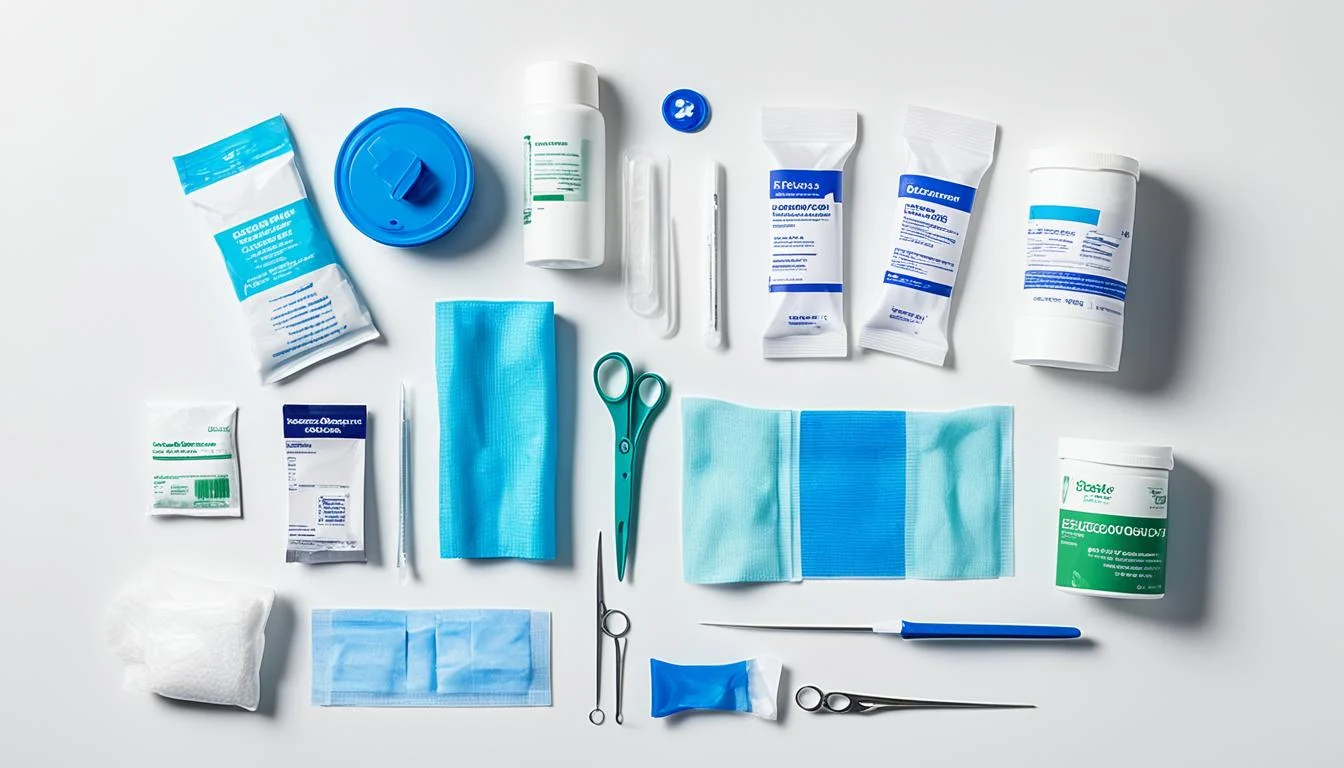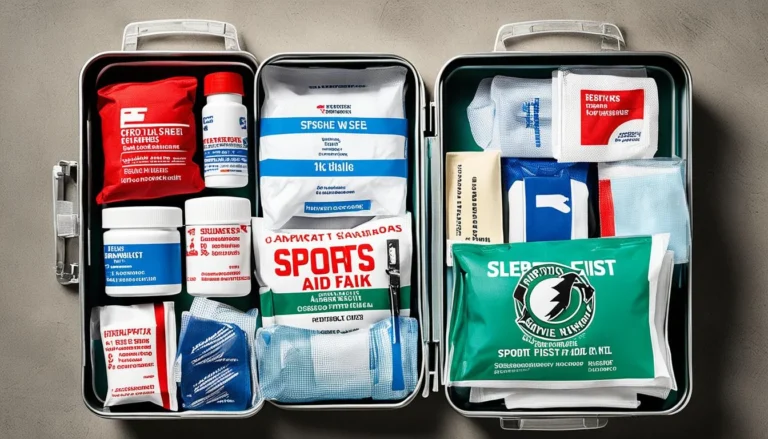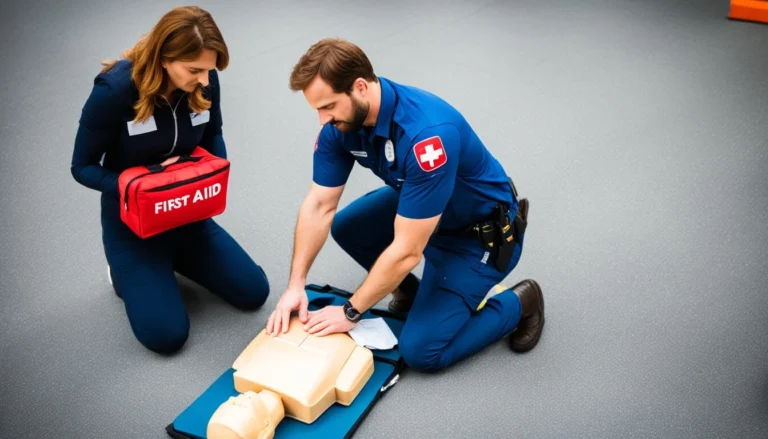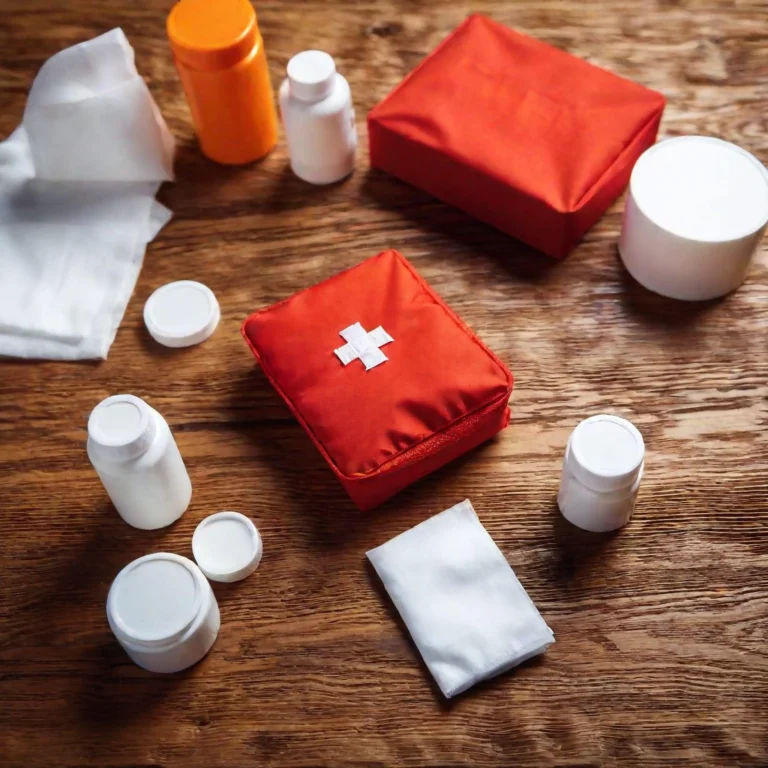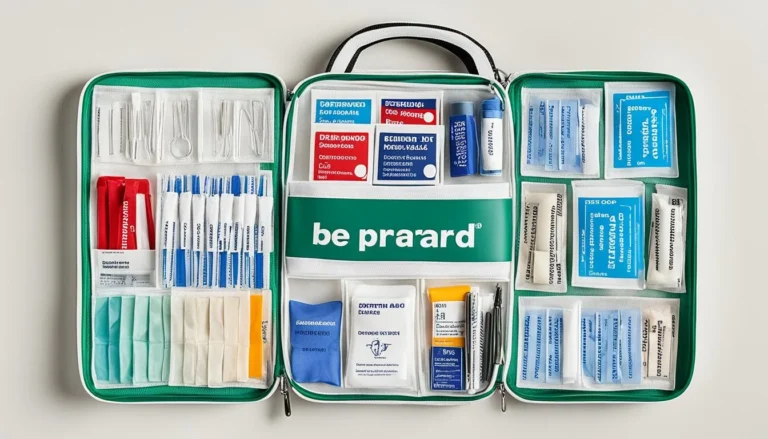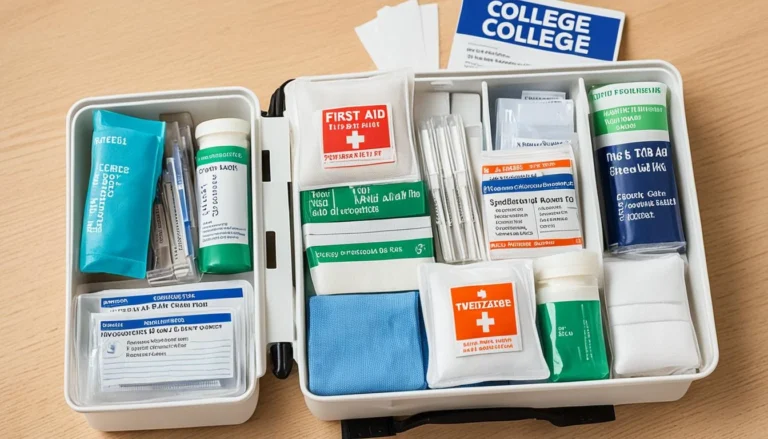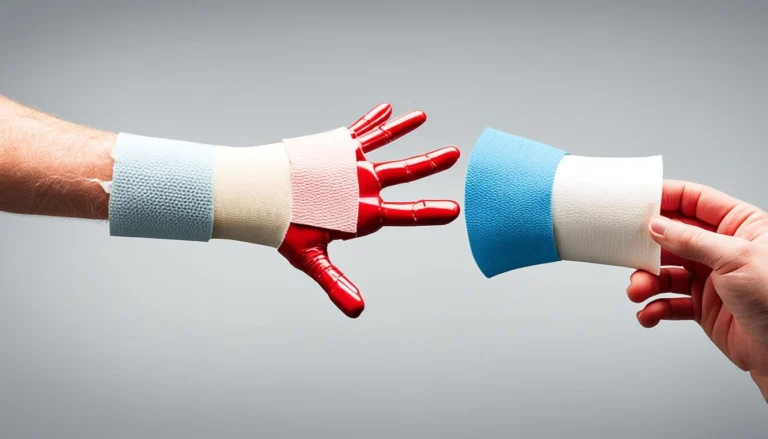What To Put In A Homemade First Aid Kit – Essential Items
Creating your own first aid kit means you’re ready for small medical needs. Knowing what to include is vital for your family’s health. Make sure to regularly update your kit and check expiry dates of medical items. Also, add personal info and any medications for a fully customised kit.
Key Takeaways
- Gather essential items that cater to your household’s specific needs.
- Regularly check and update the contents of your first aid kit.
- Be aware of the expiration dates of all medical products.
- Include personal items such as emergency contact information and medications.
- Maintain and organise your kit for easy access during emergencies.
Introduction to DIY First Aid Kits
In tough times, a first aid kit can save lives. It gives fast help in accidents or health crises. When you can’t get to a doctor right away, a first aid kit is vital. Making your own lets you include what your family needs. This boosts home safety and how well you can help.
Why You Need a First Aid Kit
A first aid kit at home means you’re prepared for small injuries or health issues. Emergency preparedness means having what you need for sudden problems. A good kit brings comfort and care fast. It might even stop things from getting worse.
Store-Bought vs. Homemade First Aid Kits
Homemade first aid kits often beat store ones. Store kits have basic items. They might not suit your family. A custom first aid kit can have exactly what you need. This makes it better for home safety emergencies, as you’ve planned for it.
Below is a look at how store kits and homemade ones compare:
| Feature | Store-Bought Kit | Homemade Kit |
|---|---|---|
| Contents | Generic | Personalised |
| Flexibility | Limited | High |
| Cost | Varies | Customisable |
| Suitability | General | Specific to Family Needs |
Choosing the Right Container
The perfect first aid kit container keeps your emergency supplies safe and ready. You should look for a container that is tough and keeps out water. This is key for keeping medical items clean and useful.
Water-Resistant Container Options
For your first aid kit, a container that keeps things dry is a must. You can use hard plastic cases that seal tight, fabric pouches with waterproof insides, or special containers made for tough weather. These choices protect your supplies, especially those that are easily ruined by water.
Organising Your First Aid Supplies
Keeping your emergency supplies organised means you can find things fast in a crisis. You might want a container with lots of sections to sort your items. This makes better use of space and keeps stuff in order.
It helps to sort your supplies by what you use most. Here’s why:
- Keep things like band-aids and wipes easy to grab.
- Put items you need less, like splints, in another spot.
First Aid Kit Essentials for Wound Care
A good first aid kit is key for caring for wounds. It should have items to clean, protect, and help heal. This helps stop infections and makes recovery quicker. Make sure these items are in your kit.
Antiseptic Wipes and Solutions
First, you need antiseptic products to fight infection. Include wipes and solutions like hydrogen peroxide or Bactine. Clean wounds first to remove bacteria and debris. This step is crucial for proper wound care.
Bandages, Dressings, and Gauze
Having different types of bandages, dressings, and gauze is very important. They keep wounds of all shapes and sizes protected. Sterile gauze is good for various wounds, and adhesive bandages work well for small cuts. The way you use these items matters a lot.
Hydrocortisone and Antibiotic Ointments
Once the wound is clean and bandaged, apply hydrocortisone and antibiotic ointments. They lower swelling and fight off germs, helping the wound heal. Hydrocortisone eases itchiness, and Neosporin ointment stops bacteria.
Medications to Include
Putting together a homemade first aid kit? The right medications are key for handling many issues. Supplying various meds ensures you can care for different needs.
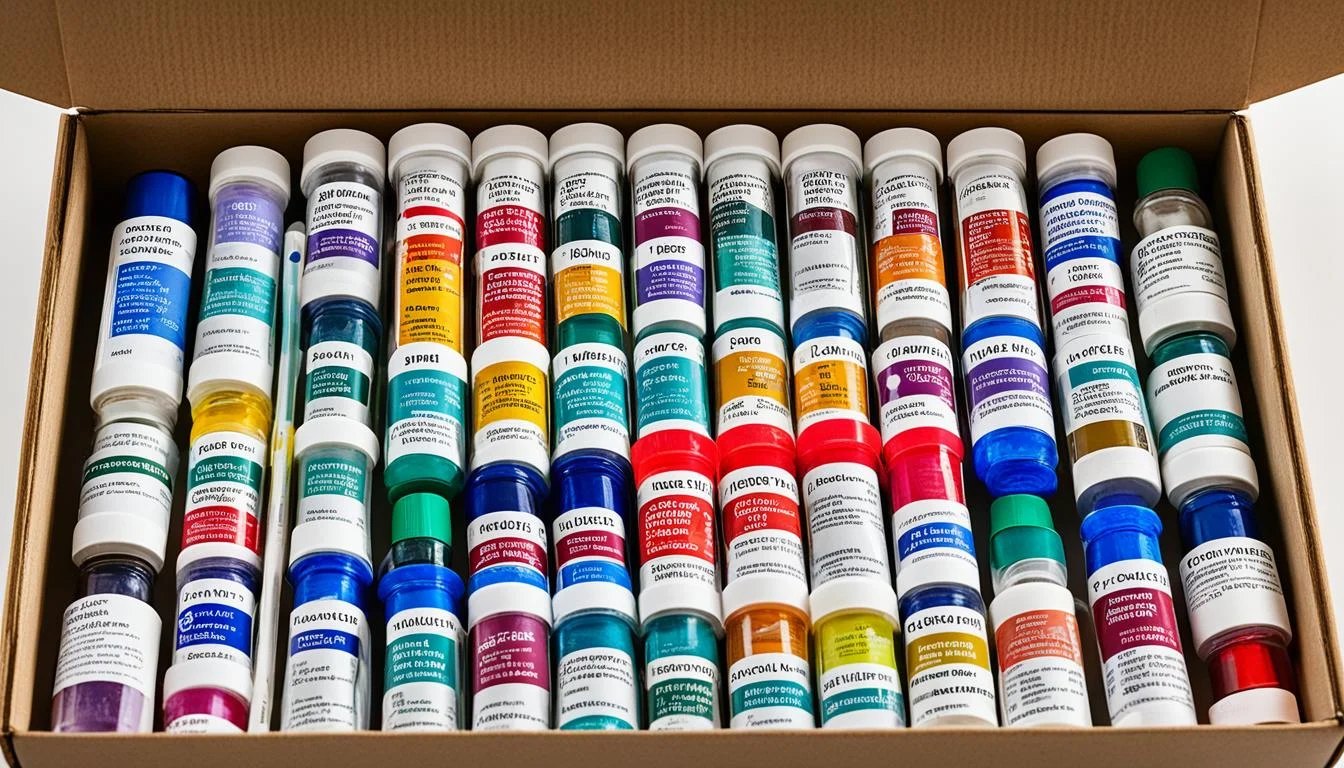
Pain Relievers: Aspirin, Ibuprofen, and Acetaminophen
Pain relief is critical in any kit. Aspirin, ibuprofen, and acetaminophen meet many people’s needs. Aspirin helps with headaches, ibuprofen reduces swelling, and acetaminophen is good for those who can’t take aspirin or ibuprofen.
Antihistamines and Diarrhoea Medications
Antihistamines help with allergies, tackling itching and sneezing. Diarrhoea medications ensure fast relief from upset stomachs. They are key for overall health care.
Cold and Flu Tablets
Cold and flu tablets offer comfort for quick illnesses. They tackle congestion, fever, and sore throats. Including these can help deal with common sicknesses.
Here’s a detailed table of emergency meds and what they are good for:
| Medication | Use | Type of Relief |
|---|---|---|
| Aspirin | Headaches, minor aches | First aid pain relief |
| Ibuprofen | Inflammation, pain | First aid pain relief |
| Acetaminophen | Pain, fever | First aid pain relief |
| Antihistamines | Allergic reactions | Allergy remedies |
| Diarrhoea Medications | Stomach upsets | Treatment of diarrhoea |
| Cold and Flu Tablets | Cold, flu symptoms | Symptom relief |
Basic Medical Tools
It’s key to have basic medical tools in your first aid kit. They are vital for quick and accurate response to emergencies. This ensures the right care is given during injury treatment.
Thermometer and Instant Cold Compress
Reading body temperature is important. A thermometer helps check for fevers to see if action is needed. Instant cold compresses quickly ease injuries like sprains, helping to lower pain and boost healing.
Blunt-Tip Scissors and Tweezers
Blunt-tip scissors are for cutting bandages or clothes without more harm. They are great for quickly treating wounds in emergencies. Tweezers are vital for pulling out splinters or debris from cuts, making injury care better.
Elastic Bandages and Splints
Elastic bandages do a lot. They support sprains and squash injuries to lessen swelling. Splints are crucial for holding broken bones or major sprains still, until you get expert medical help.
| Medical Instrument | Uses |
|---|---|
| Thermometer | Monitoring fevers |
| Instant Cold Compress | Reducing swelling and pain |
| Blunt-Tip Scissors | Cutting bandages/clothing safely |
| Tweezers | Removing splinters/debris |
| Elastic Bandages | Supporting and compressing injuries |
| Splints | Immobilising fractures/sprains |
Personal Items to Add
It’s key to add personal items to your first aid kit. This helps address your own health needs. Remember to include the following:

Emergency Contact Information
Having emergency contact information is very important. Include details for doctors, dentists, and family. Always keep this info current to get help fast.
Personal Medications
Add your personal medications to the kit. Keep them in their original packaging with clear instructions. This makes managing your health easier during emergencies.
Allergy Information and Medical Conditions
Be sure to note any allergies and conditions you have. This info is crucial for those helping you in emergencies. It could even save your life.
First Aid Kit Safety Tips
Being careful with first aid kits is really important. Make sure to look over your supplies often. Check that everything, like bandages, is clean.
Always keep an eye on when things expire. It’s key to swap out old items. For instance, don’t use medicine past its expiry. It might not help and could be harmful.
Remember, tech items like thermometers need working batteries. Check them and always have spares ready.
Knowing how to use each item is crucial for helping others safely. For example, cleaning a wound well can stop the spread of infection.
Follow this simple list to enhance your first aid skills:
- Regularly inspect and update your first aid kit
- Ensure all items are within their use-by dates
- Check the functionality of electronic devices
- Familiarise yourself with the proper use of each kit item
Maintaining and Updating Your First Aid Kit
Keeping your first aid kit up to date is essential for emergency readiness. Check it often and replace items as needed. This keeps the kit working effectively.
Regular Checks and Replacements
It’s important to regularly review what’s in your first aid kit. Make sure to replace used items and those close to expiring. Also, check supplies to ensure they are still fit for use.
Understanding Expiry Dates
Expiration dates matter, especially for antiseptics and medicines. Using out-of-date products can be risky. Keep track of these dates and replace expired stuff immediately to stay safe.
Specific First Aid Kit Tips for Families
In an emergency, every family member’s needs are important, even your pets. Having a first aid kit ready is crucial for quick action.
Child-Friendly Supplies
Include items specially for kids in your kit. Add medicines just for children and fun bandages they’ll like. This helps them feel less scared when they’re hurt.
Educating Kids About First Aid
Teaching your kids about first aid is also key. Show them how to treat small injuries. It gives them confidence when an adult can’t help right away. Fun exercises help them remember the important stuff.
Pet First Aid Items
Pets need first aid too. Pack pet-friendly items like wound care and their medications. This ensures you’re prepared for pet emergencies too.
| Items | Purpose |
|---|---|
| Character Bandages | Makes wound dressing less intimidating for children |
| Children’s Paracetamol | Pain relief for kids |
| Pet-Safe Antiseptics | For treating pet wounds safely |
| Pet Medications | Ensures pets receive necessary treatments in emergencies |
What To Put In A Homemade First Aid Kit
Creating a homemade first aid kit is crucial. It ensures you are prepared for emergencies and can take care of yourself when needed. Start with basic wound care items like antiseptic wipes, bandages, and gauze. These help clean and protect wounds, stopping infections and speeding up healing.
Don’t forget items like hydrocortisone cream and antibiotic ointments. They’re great for treating minor cuts and rashes. These medications greatly help in self-treatment.
Pain relievers are essential. Include aspirin, ibuprofen, and acetaminophen to cover different types of pain. Antihistamines are good for allergies, and cold and flu tablets handle respiratory issues.
Also, remember basic medical tools. A thermometer is key for monitoring fevers. Instant cold compresses give quick help for sprains. Scissors, tweezers, bandages, and splints are crucial too for minor emergencies.
Make your kit personal by adding emergency contacts and your medications. Keep it updated to ensure everything is usable when needed. This makes you ready for any minor medical situation at home.

